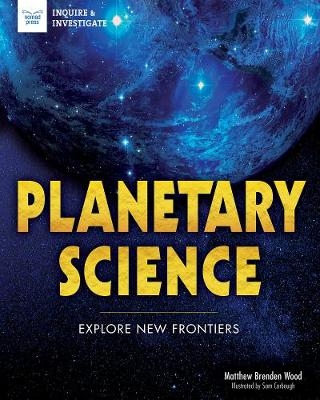
Planetary Science
Nomad Press (Verlag)
978-1-61930-567-0 (ISBN)
- Keine Verlagsinformationen verfügbar
- Artikel merken
What do you see when you look up into the sky at night? The moon, stars, maybe even a comet or asteroid? You can also see other planets!
In Planetary Science: Explore New Frontiers, readers ages 12 to 15 embark on a journey through the solar system and beyond, exploring planets, moons, dwarf planets, exoplanets and everything in-between. For many ancient cultures, planets were mysterious objects that moved against the backdrop of the heavens in strange but predictable patterns. Ever since Galileo Galilee first used a telescope to explore the moons of Jupiter, we've known that the planets are much more than mysterious points of light in the night sky. With the creation of incredible technologies such as space probes, giant ground-based telescopes, and Earth-orbiting observatories, we've learned that Mars once had water on its surface, that Jupiter's Great Red Spot has been churning for centuries, and that thousands of exoplanets circle distant suns. Planetary science is also exciting because of what we don't know. Was there ever life on Mars? Is Planet Nine lurking in the outer reaches of the solar system? Will we ever find another Earth? How far can we go? In Planetary Science, readers examine the latest information on Pluto, the discoveries of the Mars rover Curiosity, and the incredible catalog of distant planets uncovered by the Kepler Space Telescope. They learn about how planets are formed and why they travel on their orbits. Planets, those pinpricks of light you might spot on a clear night, come closer through informative illustrations, links to online primary sources, illuminating sidebars and fun facts, and hands-on, in-depth activities, such as building scale models of planets, hunting for alien worlds through citizen science, and crafting a comet in the kitchen. Planetary Science also promotes critical thinking skills through inquiry, discovery, and research by encouraging readers to explore questions that remain unanswered, such as whether Mars once had life or the possibility of a ninth planet hiding in the furthest reaches of the solar system. With discoveries being made almost every day, it's an exciting time to be a planetary scientist!
Matthew Brenden Wood, author of The Science of Science Fiction, is a math and science teacher with a passion for STEAM education. He is also an avid amateur astronomer and astrophotographer. Wood holds a bachelor's degree in astronomy from the University of Massachusetts at Amherst and lives in Phoenix, Arizona.Sam Carbaugh has illustrated several books for Nomad Press, including Forensics: Uncover the Science and Technology of Crime Scene Investigation and Shakespeare: Investigate the Bard's Influence on Today's World, and he wrote and illustrated Comics: Investigate the History and Technology of American Cartooning. Sam lives in Grand Rapids, Michigan.
Map of the Solar System
Introduction: Studying Other Planets
Can You Spot Mercury?
Chapter 1 The Hot Planets: Mercury and Venus
Make Your Own Crater
Discovering Density
Chapter 2 The Cool Planets: Earth and Mars
Modeling the Inner Planets
Investigate the Hydrologic Cycle
Model the Earth-Moon System
Chapter 3 The Gas Giants: Jupiter and Saturn
Saturn's Rings
Investigate Tidal Forces
Inside Europa
Chapter 4 The Ice Giants: Uranus and Neptune
A Mission to the Ice Giants
Modeling the Outer Planet
Chapter 5 Dwarf Planets, Asteroids, and Comets
Scale Models of the Dwarf Planets
Asteroids Make Impact
Create Your Own Comet
Chapter 6 Exoplanets and Planet
Model an Alien Planet
Glossary
Metric Conversions
Resources
Index
| Erscheinungsdatum | 01.02.2018 |
|---|---|
| Illustrationen | Samuel Carbaugh |
| Verlagsort | VT |
| Sprache | englisch |
| Maße | 204 x 254 mm |
| Themenwelt | Kinder- / Jugendbuch ► Sachbücher ► Naturwissenschaft / Technik |
| Kinder- / Jugendbuch ► Sachbücher ► Tiere / Pflanzen / Natur | |
| Schulbuch / Wörterbuch | |
| ISBN-10 | 1-61930-567-4 / 1619305674 |
| ISBN-13 | 978-1-61930-567-0 / 9781619305670 |
| Zustand | Neuware |
| Haben Sie eine Frage zum Produkt? |
aus dem Bereich


